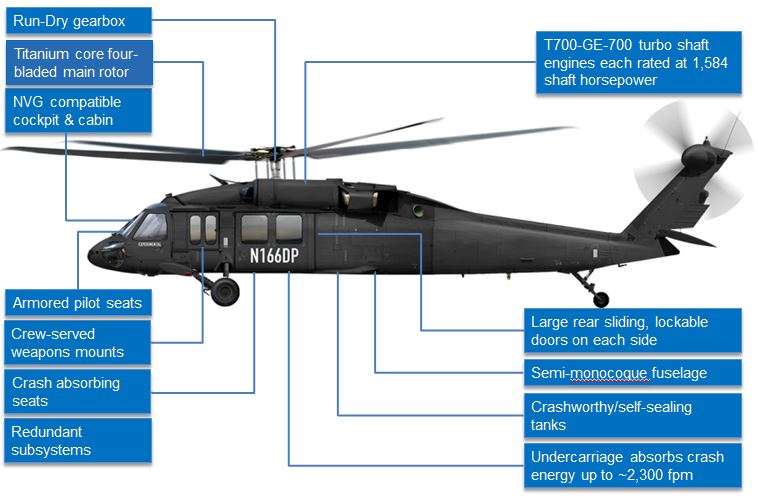Understanding the Mechanics and Engineering Behind Uh 60 Helicopters
The UH-60 helicopter, typically recognized as the Black Hawk, stands as a peak of modern-day rotorcraft modern technology, personifying a blend of robust engineering and complex mechanics. As we peel back the layers of the UH-60's design, a world of complex systems and thorough engineering comes to light.
Background of UH-60 Helicopters
The history of UH-60 helicopters traces back to the late 1970s when the USA Army sought a flexible and sophisticated energy helicopter to replace its aging fleet. In action to this demand, the Sikorsky Aircraft Firm established the UH-60 Black Hawk helicopter. Presented in 1979, the UH-60 promptly ended up being a staple in army operations because of its impressive capabilities.
The UH-60 was designed to master a range of objectives, including army transport, medical emptying, digital war, and special operations. Its ability to adapt to various functions made it a valuable property to the U.S. uh 60. Army and various other military forces worldwide
Throughout the years, the UH-60 platform has gone through several upgrades and variations to improve its performance and equal developing goal needs. These helicopters have actually seen substantial solution in disputes such as the Gulf War, Afghanistan, and Iraq, showcasing their integrity and flexibility in varied operational settings. The UH-60's rich history is a testimony to its enduring heritage as a top energy helicopter.

Engine and Power Systems
Using sophisticated propulsion innovation, UH-60 helicopters are furnished with advanced engine and power systems to make certain optimal performance and reliability in a variety of functional scenarios. The UH-60, commonly recognized as the Black Hawk, is powered by two General Electric T700-GE-701D engines, each with the ability of providing up to 1,940 shaft horse power. These turboshaft engines provide the essential drive for the helicopter to accomplish its missions successfully, consisting of army transportation, clinical discharge, and fight assistance.

Rotor System and Aerodynamics
Just how do the rotor system and the rules of aerodynamics of UH-60 helicopters contribute to their functional effectiveness and trip abilities? The rotor system of the UH-60 helicopter plays an important duty in providing lift and propulsion.
Aerodynamics likewise play a vital duty in the performance of UH-60 helicopters. The streamlined fuselage and rotor blade layout minimize drag, enabling the helicopter to attain higher speeds and better fuel effectiveness. The wind resistant design of the UH-60 also adds to its capability to operate in diverse ecological conditions, consisting of high elevations and hot temperature levels.
Avionics and Trip Control Solution

In its complex sychronisation with the web link blades system and the rules of aerodynamics of UH-60 helicopters, the avionics and flight control systems create an important network of modern technologies forming the aircraft's operational capabilities. In the UH-60, these systems consist of electronic screens, communication radios, General practitioner navigating, weather condition radar, and auto-pilot systems.
The trip control systems of the UH-60 are accountable for equating the pilot's inputs into the proper adjustments to the blades system, ensuring steady trip and ability to move. These systems include hydraulic actuators, servos, and computers that collaborate to control the major and tail rotors, as well as various other flight control surfaces. By specifically handling the helicopter's flight characteristics, these systems make it possible for pilots to perform a large range of goals, from transportation and search-and-rescue to deal with operations, with accuracy and confidence.
Function and Applications in Aviation
Avionics systems in UH-60 helicopters include an array of electronic systems that help in navigation, communication, monitoring, and controlling various airplane features. These systems consist of digital screens, auto-pilot systems, interaction radios, General practitioner navigation equipment, and weather radar. see page In addition, these systems incorporate safety attributes such as autopilot modes, terrain awareness alerting systems, and security enhancement systems to boost the total safety and security and functional abilities of the UH-60 helicopters in different objectives, consisting of troop transportation, medical discharge, search and rescue, and airborne firefighting.
Verdict
In verdict, the UH-60 helicopter is a flexible aircraft with an abundant history and progressed design. Its engine and power systems, blades system, aerodynamics, avionics, and flight control systems all interact to make it a reliable and effective maker. The UH-60's function and applications in aeronautics are huge, ranging from military procedures to search and save missions. Its continued advancement and usage demonstrate its value in the field of air travel (uh 60).
In its complex coordination with the blades system and the rules of aerodynamics of UH-60 helicopters, the avionics and flight control systems develop an important network of modern technologies shaping the aircraft's operational capacities.The flight control systems of the UH-60 are liable for converting the pilot's inputs into the proper modifications to the rotor system, making certain stable flight and ability to move. Avionics systems in UH-60 helicopters include a variety of digital systems that aid in navigation, interaction, surveillance, and managing numerous airplane features. Additionally, these systems incorporate safety and security functions such as auto-pilot modes, terrain awareness alerting systems, and stability augmentation systems to boost the general security and operational abilities of the UH-60 helicopters in different goals, consisting of army transport, medical discharge, search and rescue, and aerial firefighting.
Its engine and power systems, blades system, the rules of aerodynamics, avionics, and flight control systems all function with each other here to make it a effective and dependable equipment.